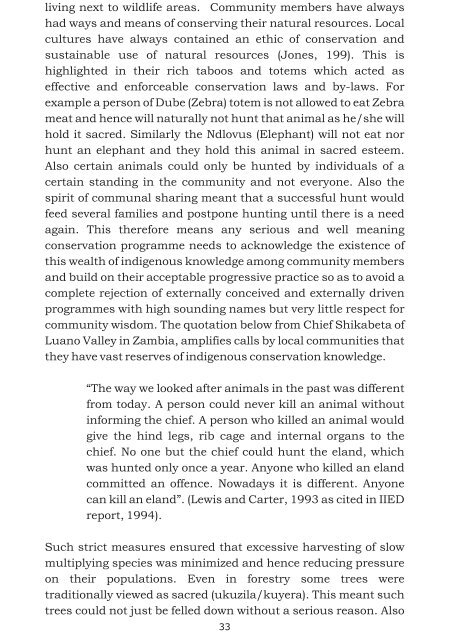Beneficiaries are actors too.pdf - Southern Institute of Peace ...
Beneficiaries are actors too.pdf - Southern Institute of Peace ...
Beneficiaries are actors too.pdf - Southern Institute of Peace ...
Create successful ePaper yourself
Turn your PDF publications into a flip-book with our unique Google optimized e-Paper software.
living next to wildlife <strong>are</strong>as. Community members have always<br />
had ways and means <strong>of</strong> conserving their natural resources. Local<br />
cultures have always contained an ethic <strong>of</strong> conservation and<br />
sustainable use <strong>of</strong> natural resources (Jones, 199). This is<br />
highlighted in their rich taboos and totems which acted as<br />
effective and enforceable conservation laws and by-laws. For<br />
example a person <strong>of</strong> Dube (Zebra) totem is not allowed to eat Zebra<br />
meat and hence will naturally not hunt that animal as he/she will<br />
hold it sacred. Similarly the Ndlovus (Elephant) will not eat nor<br />
hunt an elephant and they hold this animal in sacred esteem.<br />
Also certain animals could only be hunted by individuals <strong>of</strong> a<br />
certain standing in the community and not everyone. Also the<br />
spirit <strong>of</strong> communal sharing meant that a successful hunt would<br />
feed several families and postpone hunting until there is a need<br />
again. This therefore means any serious and well meaning<br />
conservation programme needs to acknowledge the existence <strong>of</strong><br />
this wealth <strong>of</strong> indigenous knowledge among community members<br />
and build on their acceptable progressive practice so as to avoid a<br />
complete rejection <strong>of</strong> externally conceived and externally driven<br />
programmes with high sounding names but very little respect for<br />
community wisdom. The quotation below from Chief Shikabeta <strong>of</strong><br />
Luano Valley in Zambia, amplifies calls by local communities that<br />
they have vast reserves <strong>of</strong> indigenous conservation knowledge.<br />
“The way we looked after animals in the past was different<br />
from today. A person could never kill an animal without<br />
informing the chief. A person who killed an animal would<br />
give the hind legs, rib cage and internal organs to the<br />
chief. No one but the chief could hunt the eland, which<br />
was hunted only once a year. Anyone who killed an eland<br />
committed an <strong>of</strong>fence. Nowadays it is different. Anyone<br />
can kill an eland”. (Lewis and Carter, 1993 as cited in IIED<br />
report, 1994).<br />
Such strict measures ensured that excessive harvesting <strong>of</strong> slow<br />
multiplying species was minimized and hence reducing pressure<br />
on their populations. Even in forestry some trees were<br />
traditionally viewed as sacred (ukuzila/kuyera). This meant such<br />
trees could not just be felled down without a serious reason. Also<br />
33


